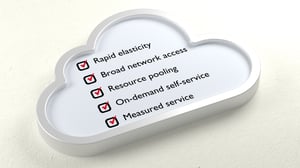 As we discussed in our white paper, “Augmenting and Enhancing Your Existing Network with a Hybrid Cloud,” there are many advantages of a hybrid cloud model such as greater levels of redundancy and elasticity. To acquire the advantages that a hybrid cloud offers requires a lot of planning and preparation. We have compiled a comprehensive checklist to aid you in the preparation of your deployment.
As we discussed in our white paper, “Augmenting and Enhancing Your Existing Network with a Hybrid Cloud,” there are many advantages of a hybrid cloud model such as greater levels of redundancy and elasticity. To acquire the advantages that a hybrid cloud offers requires a lot of planning and preparation. We have compiled a comprehensive checklist to aid you in the preparation of your deployment.
STATE THE PURPOSE OF WHY YOU WANT TO MOVE TO A HYBRID CLOUD AND WHAT YOU WANT TO ACHIEVE
There’s a lot of hype about the cloud and rightly so due to the exciting opportunities it offers, but don’t simply jump into cloud computing because you think you are missing the boat. You need clear objectives in order to justify such a transition in not only resource allocation but computing philosophy as well. Some examples may be:
- Move your organization to Office 365 to host your email, personal files and AD accounts
- Configure a cloud bursting solution for seasonal spikes and unpredicted peaks in demand that exceed the capacity of your data center
- Create a Disaster Recovery site that can be utilized for both disasters and load balancing
- Integrate an Identity Management solution that offers Single Sign-On (SSO) for the majority of your enterprise applications
ASSESS YOUR NETWORK INFRASTRUCTURE
If you don’t currently utilize cloud computing, you need to assess your network bandwidth to ensure that your users get the same performance from the cloud that they experience within the LAN. Both the hybrid and public cloud models will increase the utilization of your Internet bandwidth. You need to identify and rectify any latency bottlenecks. Increasing your Internet to a 2GB pipe or more will have little impact if it still connects to a 1GB interface on your firewall. You need to assess your routers and core switches as well. The location of your data and services, and data when accessing them should be totally transparent from a performance point of view. Remember that large amounts of data will be traveling to, and back from the cloud if you are utilizing the cloud as a primary storage silo.
EVALUATE THE SKILL SET OF YOUR IT STAFF
Don’t just assume that your IT staff has the necessary skills to successfully manage a cloud environment or that they can adapt to it quickly. The traditional network is designed around making the user experience as managed and controlled as possible in an infrastructure defined by standard protocols. The cloud on the other hand is designed to support web services and is about elasticity, agility, and perpetual alteration. It is a world in which applications are assigned and not installed.
A good example of this distinction is Microsoft Azure. Many IT managers assume Azure simply be the cloud version of Server AD. Although the two definitely have things in common, there are also distinct differences between them as well. The primary reason to implement a hybrid cloud model is to augment your traditional on-premise network, not simply duplicate it. The manner in which IT personnel will access and configure resources will differ from that of the traditional network as the cloud is based on different protocols. It is important to designate at least one member of your staff as a cloud SME who can be relied on and can train remaining staff members.
Soft skills are essential too for IT personnel who will interact with your cloud provider. A cloud provider is in a sense a business partner and you must have staff personnel that can communicate and work with them effectively. Negotiating skills are also important when coming to a SLA.
EVALUATE COMPLIANCY, GOVERNMENT AND CORPORATE POLICY RESTRICTIONS
This is most important if you are considering hosting data in the cloud. Industry or governmental regulations may require certain data types to be stored on-premise. In some cases, your own corporate policies may require you to do the same. A thorough study of your data types should be performed in order to identify any compliancy issues. You also need to select which applications will be hosted in the cloud.
SELECT WHICH APPLICATIONS YOU WILL HOST IN THE CLOUD
You must evaluate which applications are capable of fully operating within a hybrid cloud environment. While some application types such as email or disaster recovery (DRaaS) are created with the cloud in mind, many applications are not. If in fact you are replacing server hosted applications with a cloud equivalent, you need to have a plan for how to decommission the on-premise application copy once your users have fully transitioned to the new platform.
DO YOUR HOMEWORK IN SELECTING A CLOUD PROVIDER AND NEGOTIATING A SLA
There are a number of public providers that can operate within a hybrid model environment. Sometimes the nature of your data may dictate that you only work with a vendor that specializes in providing a hosting environment that can fulfill compliance requirements and regulations. Circumstances such as these will limit your available options.
Organizations also may choose to go with a provider that can easily integrate with their on-premise environment. If your IT team already supports an established VMware virtual environment, then a transition to a provider that offers vCloud Air will be a natural integration. For those organizations firmly entrenched in Active Directory, an assimilation with Microsoft Azure may be more natural. You can also choose to incorporate multiple public clouds into your hybrid design. Remember, one of the primary benefits and draws of the cloud is the elasticity and flexibility it offers. You don’t have to stick to just one provider.
Be sure to obtain ALL of the associated costs up front from all potential providers and understand how they establish their pricing. Pricing may be based on traffic, required storage space, server CPU time or a combination of these factors along with other elements. Pricing will also depend on whether you demand bare metal servers or virtual ones. Billing should be done transparently so that you can track costs in real time just like your provider. The costs associated with transferring your data is extremely important, especially if you break your partnership at some point and want to migrate to a new provider.
Be sure to read the Service Level Agreements of all proposed providers and fully understand where the separation of responsibility and security lie between you and the provider. Be sure to get all minimum performance and security expectations in writing.
COMPARE THE UPLOAD METHODS AND MANAGERIAL PROCESSES
If you are migrating data or server resources to the cloud, you need to understand the upload process and how it is implemented. Your on-premise data center and the cloud itself may be securely locked down, but your data can be exposed during the upload process. In most cases this will involve some sort of VPN connection to encrypt the transfer process. Some vendors may provide a gateway storage appliance to handle data transfers both ways. If you are migrating some of your servers to the cloud, you may be required to manage each fleet with a separate interface, while other solutions may allow you to manage your entire enterprise from a single pane of glass.
TEST, TEST AND TEST AGAIN
Before you even think of fully migrating your production resources, conduct tests within a non-production environment. Some vendors may offer a free trial period to do this. This will give you a chance to not only become familiar with the interface of the product but discover any limitations or potential obstacles in working with your on premise environment.
About WEI
WEI is an innovative, full service, customer-centric IT solutions provider.
Why WEI? We go further.
At WEI, we’re passionate about solving your technology problems and helping you drive your desired business outcomes. We believe in challenging the status quo and thinking differently. There are a lot of companies that can take today’s technology and create a great IT solution for you. But we do more. We go further. And we have the customer, vendor and industry awards to prove it. WEI is a premier technology partner, who always puts our customers first while providing the most innovative solutions for over 30 years.


